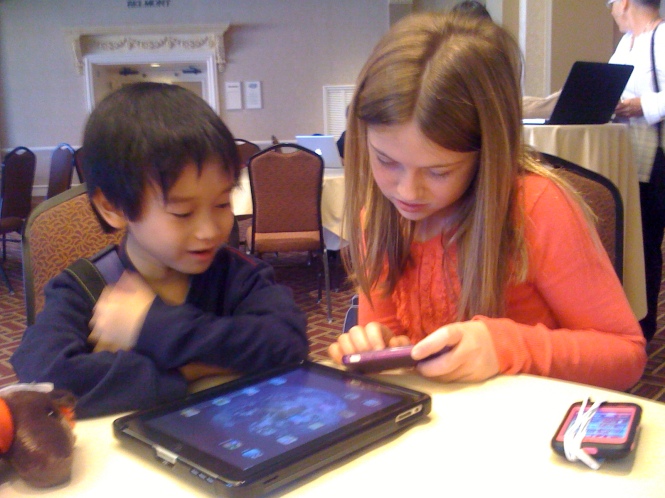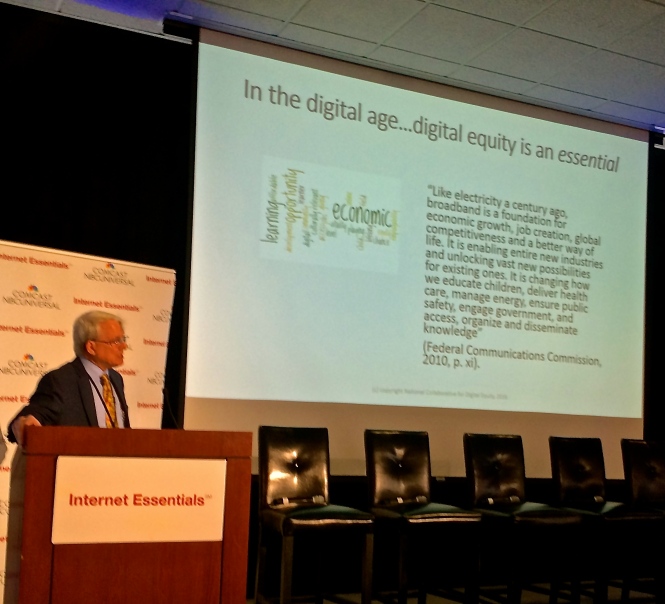There are so many “hidden audiences” . There are great “hidden mentors “who try to create the possibilities that were put forth when technology was beginning in the US for our citizens.There are some outreach groups that furnish low cost technologies, but communities do not always know how to embrace and take advantage of these opportunities.
There are organizations and institutions trying to fill the gap, to share information and to provide mentoring. Visual examples of minorities such as Mila Fuller in ISTE also show that when the resources and initiatives are given to professionals, they thrive and can provide leadership.
Some very positive examples of people sharing ideas are in Ed Tech,and there are many teacher/technology leaders.
Sadly , there is a digital divide in teachers with the most need,being able to be involved with some of the groups, so the groups have done extensive online outreach to try to bridge the gap. ESRI has major online initiatives and free software for teachers and schools.
We have not met the goals of the “Super Information Highway” .
Many have not even achieved access and now the FCC has changed its mind about assisting with the Lifelong Initiative. I have been working in support of community technology. Dr. Kevin Clark’s work and the early work of the George Lucas Education Society are there to connect with and to give examples.
Some work from their center.
“Following the belief that diversity breeds innovation in scientific endeavors, there is a national push for more diversity in the science, technology, engineering, and mathematics (STEM) workforce in order to maintain national economic competitiveness. Currently, STEM-related employment is only 28% non-White; however, greater efforts to recruit and retain underrepresented minorities should increase this figure. Amidst the attention given to supporting “leaky pipelines,” less emphasis has been placed on mitigating challenges associated with bringing diverse cultures together. This article presents a framework for supporting underrepresented minorities in building STEM-relevant skills and enhancing their ability to collaborate with peers different from themselves.”
People no longer use the term as those who are online may have forgotten that there are tribal, rural, distant,poor and urban populations who are not enjoying the uses of technology.


I am grateful for the leadership of those people who can show that we who are minorities can excel and give examples of achievement that we are ” A Nation of Opportunity”.
Long ago , when technology first entered the educational stage many of us who were making decisions about the way that technology would be used shared some ideas.
We were a diverse group of people, both Republican and Democratic, and we had these goals.
- By providing people of all ages with opportunities for lifelong learning and workplace skills development, the “Information Superhighway”should enhance each individual’s ability to create and share knowledge and to participate in electronic commerce.
We had hoped as we stated :
By the year 2000, all communities and people should have convenient access to information and learning resources available through the Information Superhighway, in their schools, colleges, universities, libraries and other community-oriented institutions.
 It is way past the year 2000. If you look around in your community, who is online and who is not? Who is meaningfully on line ? Who is coding, who is keyboarding while we in technology have moved on to new ways of working and new technologies.
It is way past the year 2000. If you look around in your community, who is online and who is not? Who is meaningfully on line ? Who is coding, who is keyboarding while we in technology have moved on to new ways of working and new technologies.
New technologies change what and how people learn. Informed by learning science, cyber-learning is the use of new technology to create effective new learning experiences that were never possible or practical before. The cyberlearning movement advances learning of important content by:
Applying scientific insights about how people learn
Leveraging emerging technologies
Designing transformative learning activities
Engaging teachers and other practitioners
Measuring deeper learning outcomes
Emphasizing continuous improvement
The Center for Cyberlearning enables ongoing learning through cooperation, broadening engagement and examples of practices .
Many are still waiting for the initial learning and scaffolding and it seems that the people with the most needs are being left behind. There is a way that teachers can embrace the new learning, though that may not give them the technology,the practice and the skills they need.

3. Education, training and lifelong learning resources , important parts of the Information Superhighway, should be of world-class quality and the diversity of these resources should be broad enough to meet the full spectrum of society’s interests.
4. Individuals and their communities should be empowered to help shape the evolution of the Information Superhighway and help to decide how information resources best meet their learning needs.
 The empowerment of the groups that are being left behind are addressed by leadership initiatives, such as that lead by Dr. Paul Resta and Dr. Robert McLaughlin. http://www.digitalequity.us/index.html
The empowerment of the groups that are being left behind are addressed by leadership initiatives, such as that lead by Dr. Paul Resta and Dr. Robert McLaughlin. http://www.digitalequity.us/index.html

Their Goals:
Help high poverty communities mobilize for sustained systemic digital equity action.
Help states to mobilize sustained digital equity initiatives.
Infuse digital equity issues and strategies into educator preparation.
Provide research and evaluation to identify best practices in digital equity that lead to educational and economic impacts.
Provide technical assistance to digital equity resource providers.
Advise digital equity investors on why and how to design efforts that are systemic so they have genuine impacts on educational and economic opportunity.
There are also pointed initiatives in STEM that seem to be unknown in many rural, distant, urban, tribal and needy communities. The reason that many cannot take advantage of opportunities is that the computers they need are also needed to complete testing in the schools.
After school does not have that problem, but they also sometimes do not have the time with participants to create meaningful uses of technology. I was so excited to see that Rafranz Davis was able to explore this technology with her students. I am learning hard lessons in after school.
Funding is? well a problem.

The children that I work with in the shadow of the capital can tell me that they play games on the computer but, can’t name the games. Many of the older students superficially use the Internet.. They use their phones, but not necessarily for the purposes that we may want. We don’t get a change to talk meaningfully about Cyber-bullying and online safety.
Bonnie Bracey Sutton
